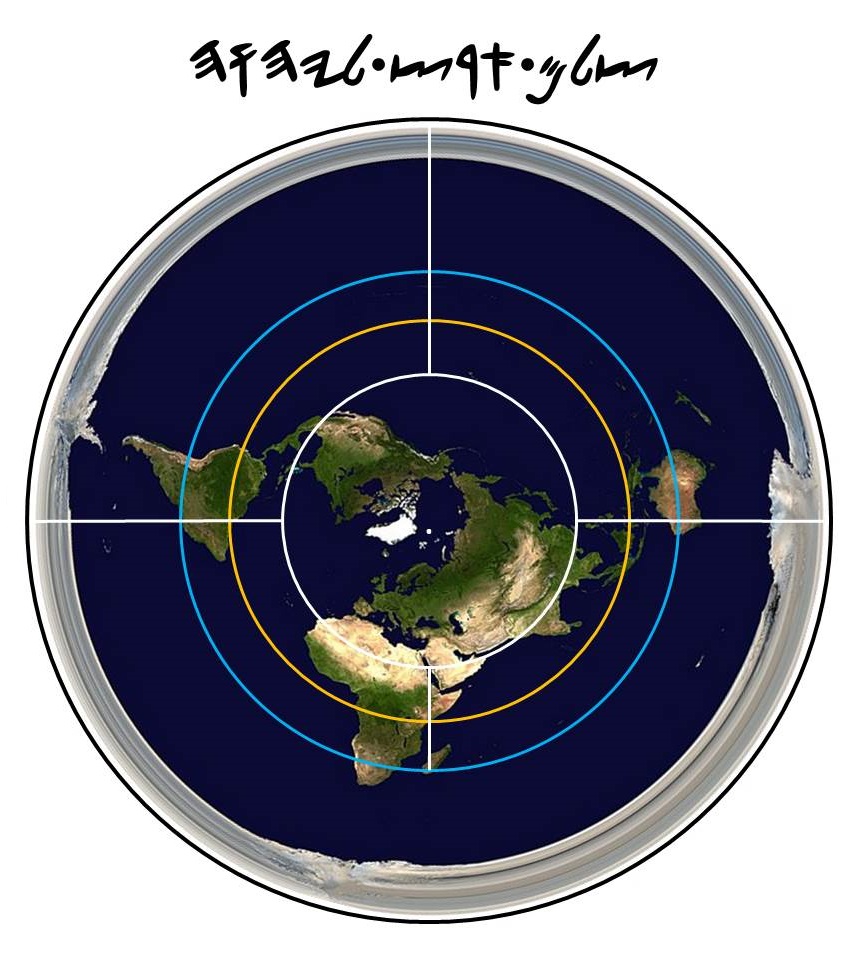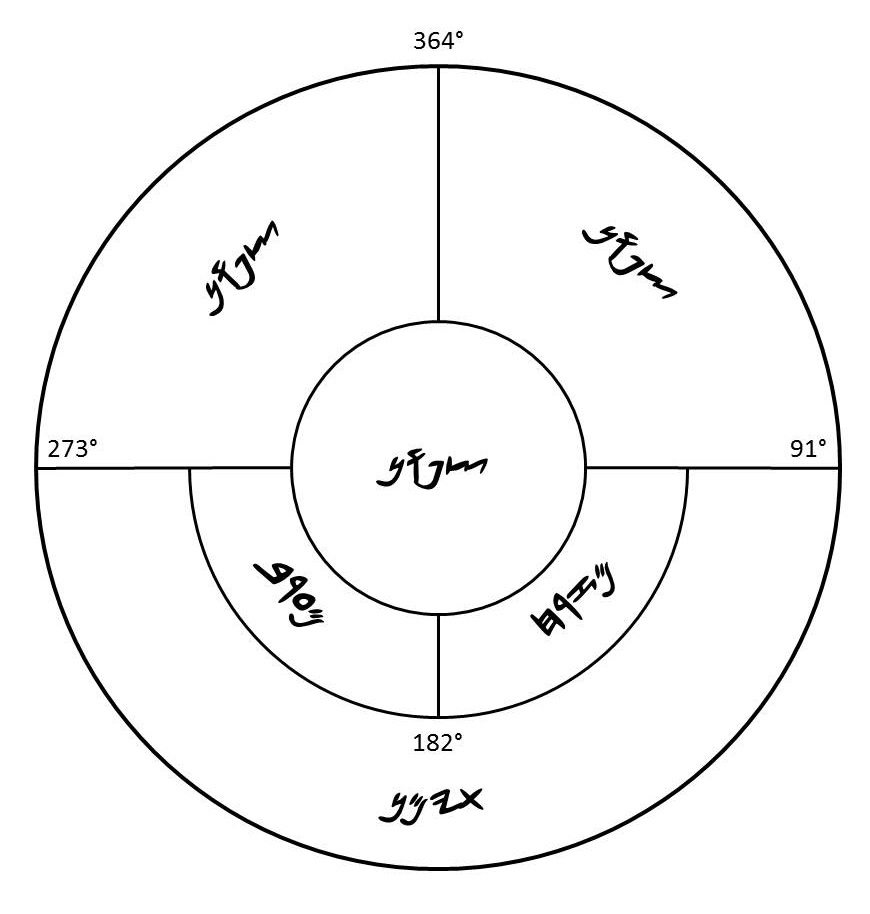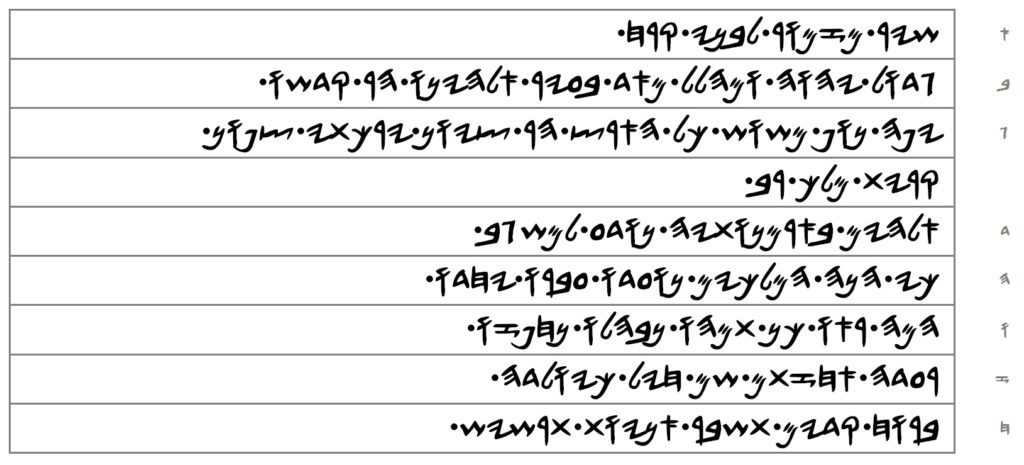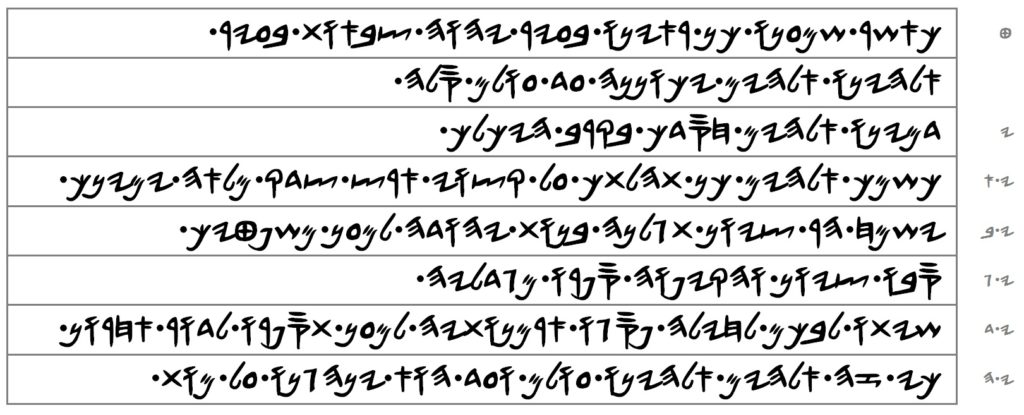

YA’OH Alah’aym created the earth to be thah’o/תהו (flat, without curvature) according to Thorah 1.1:2. When He looks down upon the face of the flat earth He sees a khog/חוג (circle, circumference) as stated in Yashai-Ya’oh 40:22. Not a sphere or a ball, but a khog. He divides the khog into arabai yarachoth/ארבע ירכות (four quarters) of unequal size. These four are: the yarachath tsapon/ירכת צפון (quarter of the north); the yarachath mazrakh/ירכת מזרח (quarter of the east); the yarachath mairab/ירכת מערב (quarter of the west); and the yarachath thayman/ירכת תימן (quarter of the south).
The yarachath tsapon/ירכת צפון (quarter of the north) is the fourth quarter of the khog. It is the largest of the four quarters and it is divided into three parts. The first part is the great circle wherein most of the world’s people live, with the north pole at its center. The heathens call this great circle the Tropic of Cancer, i.e. the most northerly circle of latitude on earth at which the sun is moving directly overhead clockwise from east to west. This occurs on the summer solstice when the sun has migrated to its maximum extent north of the equator and then turns back and heads south. This great circle is represented by the white inner circle on the above colored flat earth map. The second part of the yarachath tsapon is where Central America and most of South America is located. The third part of the yarachath tsapon is where the garden of Ghadan (Eden) was located in the far east. The northern boundary of the yarachath tsapon is the outer perimeter of the khog, which is the northern khatsay khog /חצי חוג (half circle, hemicircle). There are no hemispheres because earth is not spheriod in shape.
In a 364°-system (not the heathen’s 360°), the line of longitude from the north pole to the top of the khog at 364° divides the second and third parts of the yarachath tsapon. Extending this line to the bottom of the khog at 182° divides the khog into two hemicircles: the western and eastern hemicircles. A line of latitude at 91° of the khog straight across to 273° divides the khog into northern and southern hemicircles, and divides the second and the third parts of the yarachathay tsapon/ירכתי צפון (quarters of the north) from the yarachath thayman/ירכת תימן (quarter of the south) in the southern hemicircle.
The yarachath mazrakh/ירכת מזרח (quarter of the east) is the first quarter of the khog. It begins at the latitude of 91° in the eastern hemicircle and reaches to the line of longitude at 182°. It is bounded on the north by the first part of the yarachathay tsapon, the so-called Tropic of Cancer circle of latitude, and by the third part of the yarachath tsapon. It is bounded on the south by the great circle that the heathens call the Tropic of Capricorn, the most southerly circle of latitude on earth at which the sun is moving directly overhead clockwise from east to west. This occurs on the winter solstice when the sun has migrated to its maximum extent south of the equator and then turns back and heads north. This great circle is represented by the blue circle line on the above colored flat earth map. The yarachath mazrakh is bounded on the west at the longitude line of 182° where the yarachath mairab/ירכת מערב (quarter of the west) begins in the western hemicircle.
The yarachath mairab/ירכת מערב (quarter of the west) is the third quarter of the khog in the western hemicircle. It begins at the longitude line of 182° and arcs westward to the latitude of 273° on the khog. It is bounded on the north by the first part of the yarachathay tsapon, the so-called Tropic of Cancer circle of latitude, and by the second part of the yarachath tsapon. It is bounded on the south by the great circle that the heathens call the Tropic of Capricorn. The line of the equator runs directly through the middle of both the yarachath mazrakh and the yarachath mairab. This is represented by the yellow circle line in the colored flat earth map above. The sun is moving directly above the equator on the spring and the autumn equiluxes when the duration of daylight and darkness is equal.
The yarachath thayman/ירכת תימן (quarter of the south) is the second quarter on the face of the khog in the southern hemicircle. It begins at the latitude of 91° and arcs around to the line of latitude at 273°. It is south of the yarachath mazrakh and the yarachath mairab. The southern boundery of the yarachath thayman is the outer perimeter of the khog.
All of the detailed information above regarding the four quarters of the flat and circular earth plane is obtained from the prophets of YA’OH and from the Book of the Revolution of the Luminaries.
“The first quarter is called the east quarter, for it is the eastern. The second is called southern, for there will He descend, the One Above All, and in scattering will He descend there, the One Blessed forever. And the west quarter is called diminished, for there they pass on and go out all the luminaries of heaven. And the fourth quarter is called northern and it is divided into three parts. The first, it is for the dwelling of man. The second to the seas and the streams and the rivers and the forests and the darkness and the cloud vapor. And the third part is for the Garden of Righteousness” (Book of the Revolution of the Luminaries 6:1-3 ([1 Enoch 77:1-3]).
Notice the description of the second part of the yarachath tsapon in the above excerpt from the Book of the Revolution of the Luminaries: “The second to the seas and the streams and the rivers and the forests and the darkness and the cloud vapor.” The second part of the yarachath tsapon contains Central America and most of the continent of South America. It is hardly coincidence that Central and South America have rain forests, with South America being the wettest continent with the largest annual precipitation, and the largest river flow and evaporation. There is no way an author could know this at the time that the Book of the Revolution of the Luminaries was written without divine help from above.
The reader should also notice the description of the third part of the yarachath tsapon in the above excerpt from the Book of the Revolution of the Luminaries: “And the third part is for the Garden of Righteousness.” Mashah (Moses) writes that the garden was planted by YA’OH ma-kadam/מקדם “from the east” (Thorah 1.2:4), and what this phrase means is the point from where east begins which is at the latitude of 91° on the face of the khog in the eastern quarter of the eastern hemicircle. The garden straddled the line of latitude that divides the yarachathay tsapon from the yarachath mazrakh.
All of this was known by our Ya’oh-shar-al-ay ancestors from their inspired writings which they have handed down to us. This fact can be demonstrated, among many ways, by looking at the short Mazmor (Psalm) 48.

[1] shayr mazmor la-banay Karakh
A song. The psalm belonging to the sons of Karakh.
[2] gadol YA’OH wa-mahlal ma’ad ba-ghayr alah’ayno har kadasho
Great is YA’OH, and one to be praised greatly in the city of our Higher Power, the mount of His holiness.
[3] yapah nod mashosh chal ha-arats har Tsayon yarachathay tsapon karayth malach rab
Beautifully situated. The joy of the entire earth. Mount Tsayon. The quarters of the north. The city of the great king.
[4] alah’aym ba-armanothay-ha nodai la-mashgab
The Higher Power in its palaces is He known for a refuge high place.
[5] chay hanah ha-malachaym no’aido ghabaro yakhado
For behold, the kings were assembled, they passed by together.
[6] hamah ra’o chan thamah’o nabahlo nakhapazo
They saw, so they were dumbfounded! They were confused! They rushed away in a hurry!
[7] raidah akhaztham sham khayl cha-yoladah
Trembling seized hold on them there, pain like a woman in childbirth.
[8] ba-rokh kadaym thashabar anay’oth Tharshaysh
By the east wind will you destroy the ships of Tharshaysh
COMMENTARY OF MAZMOR 48:1-8
[Verse 1] Karakh (aka Korah) son of Ya’oh-tsahr (aka Izahr) son of Kahth (aka Kohath) son of Lo’ay (aka Levi) was the priest who led a mass rebellion against Mashah in the first wilderness (Thorah 4.16:1-3). He and his company were killed by YA’OH but the sons of Karakh were spared and they continued to serve in the priesthood (Thorah 4.26:11). This mazmor was written by Karakh’s descendants.
[Verse 2] YA’OH is indeed the praise of His people, but where is His city and the mountain of His holiness that the sons of Karakh are talking about in this mazmor?
[Verse 3] This verse has confused heathen bible interpreters for centuries. The historical Mount Tsayon located in the promised land was never the joy of the whole earth. Nor is it located in the yarachathay tsapon (quarters of the north) and we just went through a detailed breakdown of exactly what yarachathay tsapon means. Yet the heathen bible scholars believe the phrase yarachathay tsapon in Mazmor 48 is a topographical description of the situation of Mount Tsayon (Zion) to the north of the Old City of Yaroshalam (Jerusalem) in the promised land. But Mount Tsayon in this Mazmor is not a part of the city but the whole city (verses 11-12). This phrase occurs elsewhere in Yashai-Ya’oh 14:13; Ya’oh-khazak-al 38:6; 38:15; 39:2; and in ALL of these passages it means the remote quarters of the north, i.e. it means exactly what we have been talking about when we described the four quarters of the khog.
Therefore, the Mount Tsayon in Mazmor 48 is not to be confused with the historical Mount Tsayon in the promised land which lies in ruins today, waiting for the tribes of Ya’oh-shar-al to return. The Mount Tsayon of Mazmor 48 is the city that the redeemed of YA’OH will build in the second wilderness, and this second wilderness is located at the latitude of 91° on the face of the khog in the eastern quarter of the eastern hemicircle. It sits on the line of latitude that divides the yarachathay tsapon from the yarachath mazrakh. There is only one country at this location that can be described as beautifully situated and the joy of the whole earth and that is the Philippine archipelago. This is where a ravenous bird from the north has re-introduced the holy name YA’OH as prophesied in Yashai-Ya’oh 41:25 and 46:11. He will build the city (Yashai-Ya’oh 45:13) on a mountain in the second wilderness where YA’OH will be greatly praised as stated in the preceding verse 2.
[Verse 4] The city that will be built in the second wilderness will be for a place of refuge for the redeemed remnant of YA’OH who made an Exodus out of the land of their captivity in the New World. They will thrive and prosper, and they will live in palaces in their holy city. This is what the sons of Karakh foresaw and this is why they wrote this mazmor.
[Verse 5-8] These verses tell us that the leaders of the world will collectively witness the ascent of the redeemed remnant in the second wilderness, and be amazed and dumbfounded at their accomplishments. Trembling and fear will grip them as their world descends into chaos from the catastrophic meteorological wonders that will be striking the earth for the duration of a time, times, and a half that the redeemed are living secured in their mountainous stronghold in the wilderness.
The east wind destroying the ships of Tharshaysh (Tarshish) is not literal. The language is plainly metaphorical. It alludes to the weaponized weather that the redeemed remnant will call forth from the east to destroy the armies of the nations of the earth, and cripple their economies by preventing them from engaging in international trade which is done mostly by sea. Over 80% of the volume of international trade in goods is carried by the high seas in massive cargo ships, hence the ships of Tharshaysh reference, and the percentage is even higher for most developing countries. The expression is predicting the great and violent destruction to be wrought by the arm of YA’OH upon our enemies, and our chief enemy who is the chief of international trade, indeed the main target of the wrath of YA’OH, is the United States of America.

[9] cha-ashar shamaino chan ra’ayno ba-ghayr YA’OH tsaba’oth ba-ghayr alah’ayno alah’aym yachonan-ha ghad gholam salah
Like as we have heard, so we have seen in the city of YA’OH of Hosts, in the city of our Higher Power. The Higher Power will establish it unto for ever. Salah.
[10] damayno alah’aym khasad-cha ba-karab haychal-cha
We are like the Higher Power. Your mercy is in your tabernacle.
[11] cha-sham-cha alah’aym chan thahlath-cha ghal katso’ay arats tsadak mal’ah yamayn-cha
Like your name Higher Power, so is your renown upon the ends of the earth! Righteousness fills up your right hand!
[12] yashamakh har Tsayon thagalnah banoth Ya’ohdah lamain mashpatay-cha
Let it rejoice, Mount Tsayon! They will be happy, the daughters of Ya’ohdah for the sake of your judgements.
[13] sabo Tsayon wa-hakaypo-ha saparo magdalay-ha
Go around Tsayon and encompass it! Count the towers of it!
[14] shaytho lab-cham la-khayl-ha pasago armanothay-ha lamain thasaparo la-dor akharon
Set your heart to its army. Overlook the palaces of it so that you will tell the generation following.
[15] chay zah alah’aym alah’ayno gholam wa-ghad ho’ yanahgno ghal moth
For this Higher Power is our Higher Power for ever and ever. He will lead us over death!
COMMENTARY OF MAZMOR 48:9-15
[Verse 9] Like as we have heard, so we have seen, meaning the sons of Karakh who wrote this mazmor have been given a glimpse of the future city of YA’OH that will be built. It will be built in the second wilderness as an inaccessible mountain fortress, making its inhabitants secure against any hostile attack. The city will never be destroyed. It will be transferred from the wilderness to the promised land when its people relocate at the end of a time, times, and a half. The city is more than just its infrastructure. The city is its people. When the people leave the second wilderness and reclaim the promised land the city and the tabernacle of YA’OH they build leave with them. Their wealth also leaves with them (Yashai-Ya’oh 60:9).
[Verse 10] The verb damah/דמה means “likeness, similitude”. Hence the correct translation of the 1st person common plural verb damayno/דמינו is not “we have thought” as the 1611 Queen James Virus would have you believe. Even if we accept the late Masoretic punctuation which puts the verb in the intensified stem, it is still not “we have thought,” but rather “we are like”. The same verb is the origin of the noun damoth/דמות (likeness) which is used to describe the creation of Adam (Thorah 1.1:26). This verse is saying that the redeemed remnant will be like Alah’aym (the Higher Power) in the second wilderness, just like Mashah was Alah’aym to Pharaoh (Thorah 2.7:1). This mercy will be extended to the redeemed remnant in the second wilderness from YA’OH along with the mercy from Him to reconstruct His tabernacle.
[Verse 11] The name YA’OH has only recently been reintroduced. His name was reintroduced by a ravenous bird and it is now encompassing the world. Not trying to toot my own horn, but until recently no one was calling on that name, worshiping that name, praising that name, and adopting names with that name in their new names, until YA’OH caused me to proclaim His name from the far east and I came from the north (Yashai-Ya’oh 41:25). The expression tsadak mal’ah yamayn-cha (righteousness fills up your right hand) is not flowery poetry with no tangible meaning. His name is His righteousness, and He upholds the right hand of His servant Chorash to have His name proclaimed from the far east where the sun rises to the west where the sun goes down, so that the renown of YA’OH is upon the ends of the earth.
[Verse 12] The daughters of Tsayon cannot rejoice, not truthfully, while they remain captives in a strange land (Mazmor 137:4). They can only rejoice truthfully when they have made an Exodus to the second wilderness where they will build the tabernacle of YA’OH, which is the first tangible step towards getting back the promised land. I have news for you. The daughters of Tsayon are rejoicing and this is only the beginning.
[Verse 13] The redeemed remnant will have their own city in the second wilderness, as I have been saying, and they will rejoice to walk around in it, and speak of its buildings.
[Verse 14] The hearts of the redeemed will be fixated on their city and they will have an army of their own. They will guard and be on watch, overlooking their city and speaking of it to the generation that will be born and raised in the second wilderness. The imperative verb pasago/פסגו in this verse means “to overlook,” the origin of the proper noun Pasagah (the observation point on the top of a mountain) where Mashah was allowed to view and to overlook the whole promised land just before he died.
[Verse 15] YA’OH is our Alah’aym for ever and ever. This verse does not say He will lead us unto death. It says He will lead us over death, i.e. over the metaphoric death of being a captive in the land of pyramids in the New World to a new chapter of life in the second wilderness which ultimately leads to the reclaiming of the promised land in the Levant. The Mazmor ends on a high note and tells of our victory. The sons of Karakh saw all of this from YA’OH and all of it will happen. Our ascent begins in the place Beautifully situated. The joy of the entire earth. Mount Tsayon. The quarters of the north; and this is the Philippine archipelago where YA’OH put me to rally and to gather His redeemed unto the place of His name.
His name is YA’OH
Always has been. Always will be.
#EXODUS2023
1.15.7252 (April 5, 2023)

Shalom ma’ad mabayn tsadayk Chorash wa-chal chabod la-YA’OH la-chal khasad-o
Wa-hanah, amath yapah ma’ad zah shayr la-dor wa-dor, chamo ha-bayn-o.
Kom Ya’oh-shar-Al ba-ha-madbar, ba-ha-kadaym
khalak la-yarachath tsapon!
Halalo ath YA’OH Ala’aym, gholam wa-ghad Ala’ayno
I use pi as 3.18 now and not 3.14. Pi is half a circle and is in radians. If 180 degrees is 3.141592653889… then 182 degrees = 3.1765 radians. I use a compass and only use the azimuth of sun to find out what ashamarah I’m in and how many mailah ha-shamash has moved from when I saw shamash rose. At night the “Big dipper” can be used for mailah. Your fist is one mailah or 10 degrees and one can use fist to measure tj degrees sun and stars move. Idc about the pagan Roman time. Where I am at “noon” is actually 1:05 because ha-shamash appears to be at highest peak. But like I said I don’t care for the pagan Roman time. Every morning I get the azimuth sun rises and from there do my watches. Shalom.
SHALOM MABAYN YA’OHDAH this information is mind blowing, I can’t believe that the earth is not a sphere and is basically flat. The adversary works hard on trying to keep us blind deaf dumb not knowing that no one can stop the true power of YA’OH our Alah’aym . I had heard a few people over the years speak on it in passing but never with any strong conviction, TOB MA’AD TOB MA’AD little blog AKH’AY I like them all of course but this ones got me spinning. SHALOM.